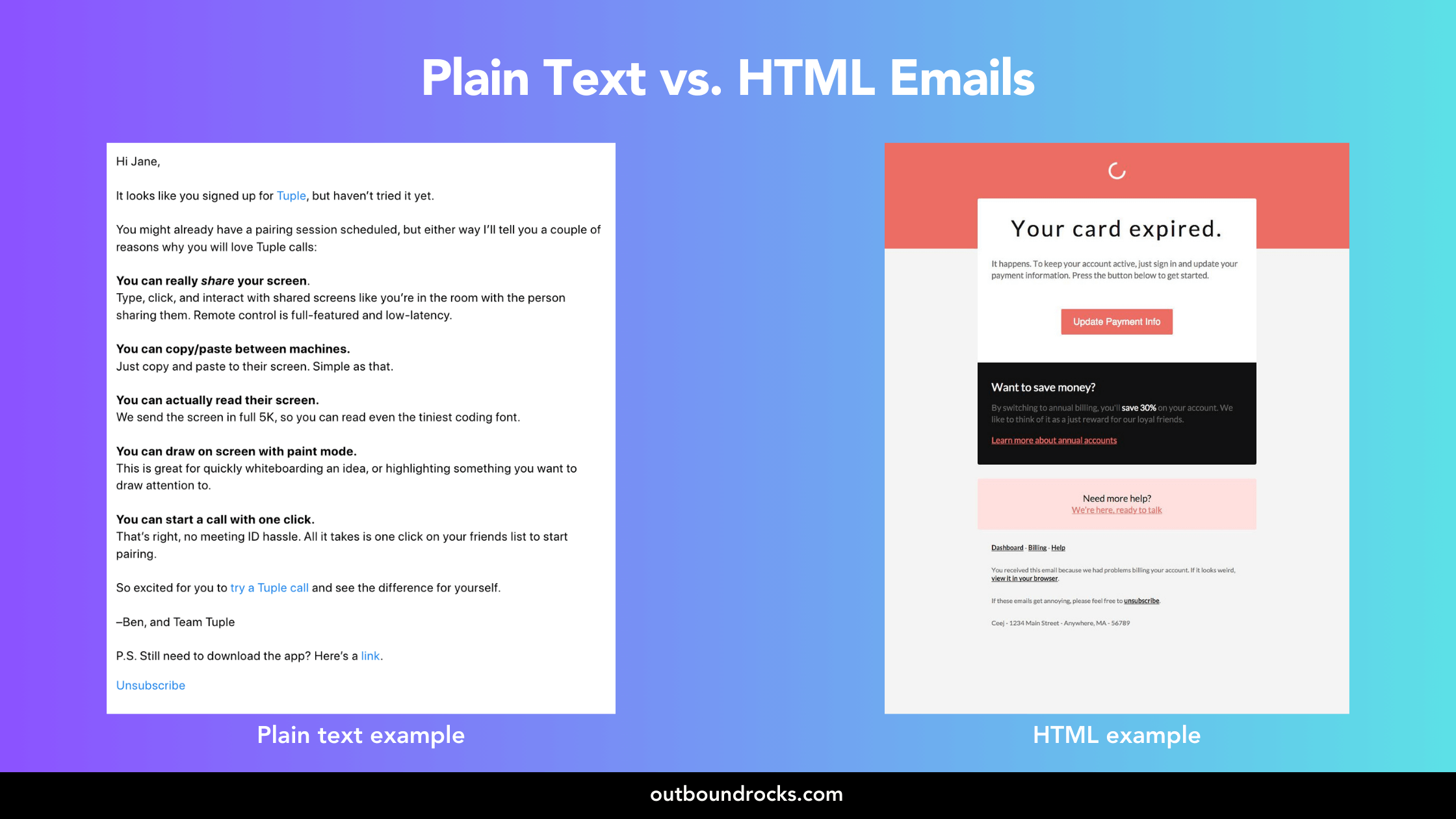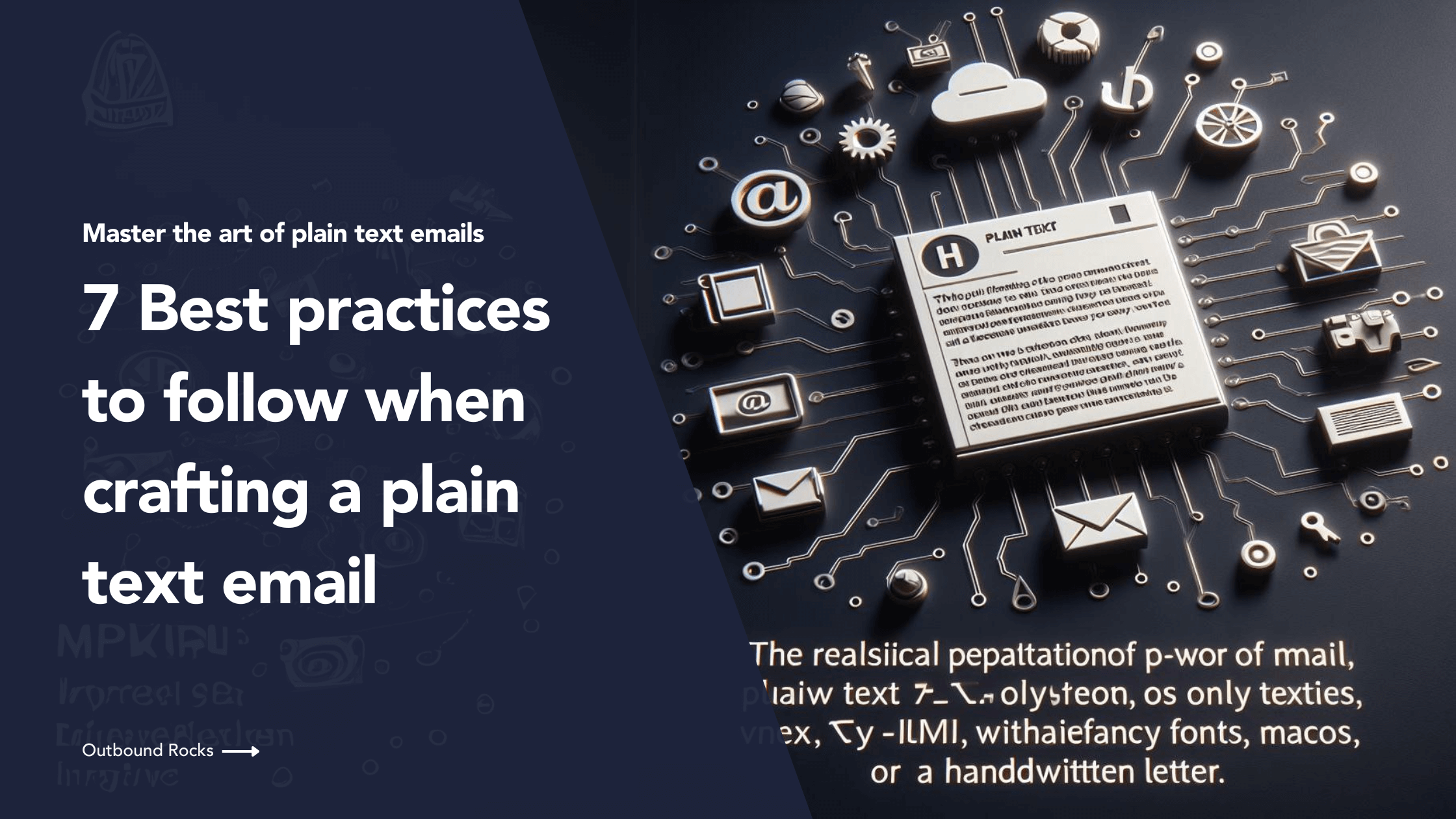While flashy HTML emails may grab attention, plain text emails can be just as effective. This text-only format offers a level of simplicity and accessibility that resonates with many readers.
But how do you create a compelling plain text email that stands out? This article takes a deep dive into the world of plain text email, exploring best practices to ensure your message is seen and acted upon.
We’ll look at the key elements of a successful plain text email and explore formatting strategies like bulleted lists and subject line optimization to maximize readability and impact.
So read on and get ready to create plain text emails that get results!
TABLE OF CONTENTS
– What is plain text email format?
– 7 best practices for plain text email
– – 1) Personalize
– – 2) Follow Up
– – 3) Format content
– – 4) Define CTAs
– – 5) Embrace the power of less
– – 6) Respect the choices of your subscribers
– – 7) Use cold email templates
– Conclusions
What is plain text email format?
A plain text email format is essentially stripped down to the bare bones of email communication. It consists only of text, without any images, videos, fancy fonts, or HTML coding. Think of it like a digital version of a handwritten letter.
While it may seem basic, plain text emails offer several advantages. They tend to be more reliable, displaying consistently across different email clients. They also load faster and are less likely to get flagged by spam filters.
According to a Benchmark report, plain text emails garner 21% higher click-to-open rates and 17% higher click-through rates than HTML email.
This means that plain text emails are ultimately better at encouraging the subscriber to take the desired action.

7 best practices for plain text email
Plain text emails may seem simple, but creating one that truly resonates with your audience requires strategic planning. In this section, we’ll explore 7 key best practices for improving your plain text emails, from personalization techniques to crafting clear calls to action (CTAs).
Let’s explore each one:
1. Personalize
A touch of personalization can go a long way. Start by addressing the recipient by name and including details specific to their situation. This shows that you’ve invested time in understanding their needs, fostering a connection and increasing engagement.
2. Follow Up
Don’t give up after one email. Sending a well-timed follow-up email demonstrates your persistence and reinforces your message. Strategically time your follow-ups to avoid being seen as pushy.
3. Format content
Since plain text emails lack fancy formatting options, keep your content concise and break it up for easy scanning. Without bold headlines or italics, you’ll need some creative techniques.
Some marketers use clear section breaks with all-caps headlines. Others highlight key points with asterisks (*) to visually separate content. The goal is to make your email scannable with capitalization and symbols. But don’t go overboard – you don’t want your email to resemble a frantic chain message.
4. Have clearly defined CTAs
Tell your readers exactly what you want them to do next. Use strong verbs and clear language in your call to action (CTA). For example, instead of saying “Learn more,” use a more direct CTA like “Click here to download the report.
5. Embrace the power of less
Unlike HTML email, plain text can’t rely on visuals to break up the content. But minimalism offers a powerful alternative.
What can you do? There are some tips:
- Resist the urge to clutter your email.
- Focus on clear, concise communication.
- Short, bulleted lists with hyphens improve readability.
- Use line breaks to create white space and separate sections of content.
- Include only essential links so they are easy to find and click.
- Avoid a cluttered “References” section with excessive links.
6. Respect the choices of your subscribers
While you may be excited about your HTML campaign, resist the urge to include a generic “view in web browser” link. This could disrespect subscribers who have opted for plain text and may not be able to view HTML versions.
Invest time in creating a compelling plain text email that is specific to their preference. This shows that you value their choice and increases the likelihood of engagement.
Remember, focusing on a well-crafted plain text version can potentially increase conversion rates for this segment of your audience.
7. Use cold email templates
Cold email templates can be a valuable time-saver, providing a starting point for personalized outreach. But resist the urge to rely entirely on generic templates. They can come across as impersonal and inauthentic.
Instead, use them strategically:
- Treat templates as a framework, not a script. Personalize each email with details specific to the recipient and their company. Mention a recent accomplishment, relevant industry trends, or a shared connection (if applicable).
- Avoid robotic, formulaic language. Use a friendly and professional tone that reflects your brand voice. Imagine you’re striking up a conversation with a potential collaborator.
- Tailor your message to highlight the specific benefits your offering holds for the recipient and their company. Focus on addressing their pain points and how your solution can make a difference.
By strategically leveraging templates and prioritizing personalization, you can craft cold emails that resonate on a deeper level, increasing the chances of a positive response.

Conclusions
At Outbound Rocks we know how to handle plaintext especially well. We only send emails as plain text as this is the natural way humans interact between each other in email communication.
To add on, we send emails during business hours and at a rate that is normal for a human being. We basically mimic human behavior.
This practice significantly increases the chances of email delivery and reduces the possibility of cold emails being marked as spam.
If you want to be delivered to your audience’s inbox, try Outbound Rocks and take your email marketing campaigns to the next level.
